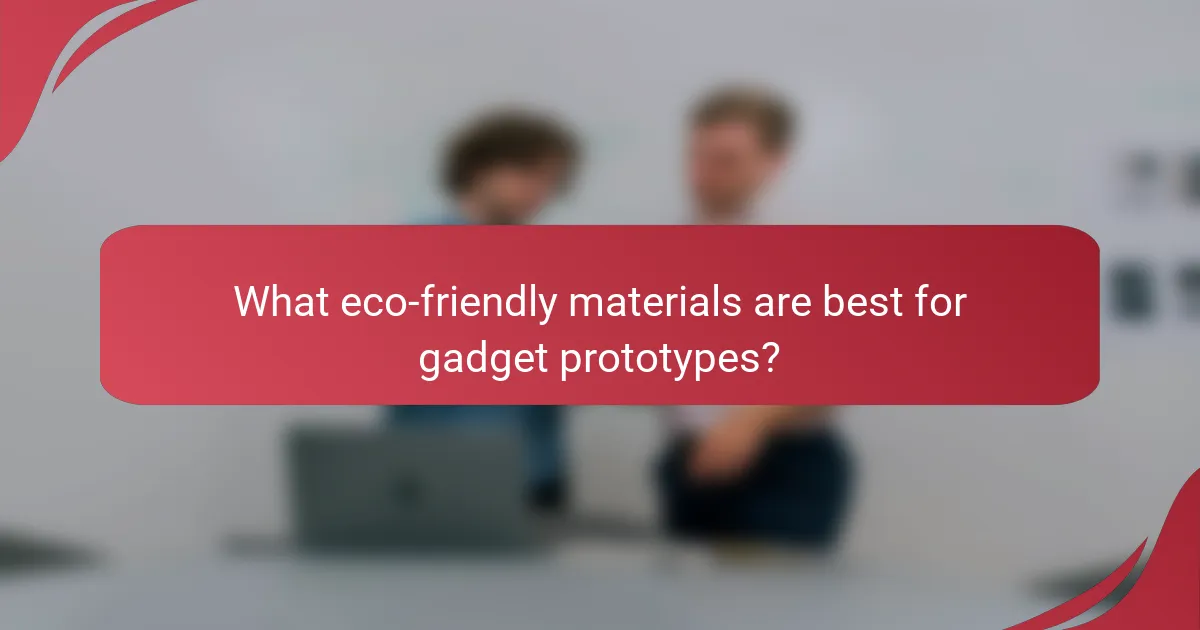In the realm of gadget prototype design, utilizing eco-friendly materials such as bamboo, recycled plastics, and biodegradable composites is essential for reducing environmental impact. By focusing on sustainability and compliance with standards like RoHS and ISO 14001, designers can create innovative products that not only meet safety regulations but also promote a healthier planet. Emphasizing energy-efficient manufacturing processes further enhances the sustainability of these prototypes, ensuring a responsible approach to technology development.

What eco-friendly materials are best for gadget prototypes?
When designing gadget prototypes, eco-friendly materials like bamboo, recycled plastics, biodegradable composites, organic cotton, and hemp are excellent choices. These materials not only reduce environmental impact but also comply with sustainability standards.
Bamboo
Bamboo is a rapidly renewable resource known for its strength and versatility. It can be used for structural components or casings in gadget prototypes, providing a lightweight yet durable option.
Consider sourcing bamboo from certified sustainable forests to ensure compliance with environmental standards. Its natural aesthetic can also enhance product appeal.
Recycled plastics
Recycled plastics, derived from post-consumer waste, help reduce landfill contributions and lower carbon footprints. They can be molded into various shapes, making them suitable for different gadget parts.
Look for plastics that meet recycling standards, such as those labeled with the recycling triangle. This ensures that your prototype not only uses eco-friendly materials but also promotes a circular economy.
Biodegradable composites
Biodegradable composites combine natural fibers with biodegradable resins, offering a sustainable alternative to traditional plastics. These materials break down more easily in the environment, reducing long-term waste.
When selecting biodegradable composites, check for certifications that guarantee their compostability. This can enhance your product’s marketability among environmentally conscious consumers.
Organic cotton
Organic cotton is grown without synthetic pesticides or fertilizers, making it a safer choice for the environment. It can be used in soft gadget covers or accessories, providing a natural feel while being eco-friendly.
Ensure that the organic cotton you choose is certified by recognized standards, such as the Global Organic Textile Standard (GOTS), to verify its sustainability claims.
Hemp
Hemp is another sustainable material that requires minimal water and no pesticides for growth. It can be used in various applications, from casings to internal components, due to its durability and strength.
When using hemp, consider its versatility and potential for integration with other materials. This can enhance the functionality and sustainability of your gadget prototypes while appealing to eco-conscious consumers.

How to ensure sustainability in gadget prototype design?
To ensure sustainability in gadget prototype design, focus on using eco-friendly materials, evaluating the product’s life cycle, and adopting energy-efficient manufacturing processes. These strategies help minimize environmental impact while maintaining compliance with relevant regulations.
Life cycle assessment
Life cycle assessment (LCA) evaluates the environmental impact of a product from raw material extraction to disposal. This process helps identify areas for improvement in sustainability, such as reducing waste and emissions during production.
When conducting an LCA, consider factors like energy consumption, water usage, and potential pollution at each stage. Using software tools can streamline this assessment, allowing for better decision-making in material selection and design modifications.
Material sourcing transparency
Material sourcing transparency involves disclosing the origins and environmental impacts of materials used in gadget prototypes. This practice builds trust with consumers and ensures compliance with sustainability standards.
To achieve transparency, establish relationships with suppliers who prioritize sustainable practices. Consider using materials that are recycled, renewable, or certified by recognized environmental standards, such as FSC for wood or GOTS for textiles.
Energy-efficient manufacturing
Energy-efficient manufacturing reduces the energy consumption associated with producing gadgets, leading to lower carbon emissions. Implementing energy-saving technologies and practices can significantly enhance sustainability in prototype production.
Consider using renewable energy sources, optimizing production processes, and investing in energy-efficient machinery. Additionally, adopting lean manufacturing principles can minimize waste and improve overall efficiency, contributing to a more sustainable design approach.

What compliance standards should be considered for eco-friendly gadgets?
When designing eco-friendly gadgets, it is crucial to consider compliance standards that ensure safety, environmental protection, and sustainability. Key standards include RoHS, REACH, and ISO 14001, each addressing different aspects of material safety and environmental management.
RoHS compliance
RoHS, or Restriction of Hazardous Substances, limits the use of specific hazardous materials in electronic and electrical equipment. Compliance ensures that products do not contain excessive levels of substances like lead, mercury, and cadmium, which can harm both human health and the environment.
To achieve RoHS compliance, manufacturers should conduct thorough testing of materials and components. This often involves working with suppliers to ensure that all parts meet the required standards. Non-compliance can lead to significant fines and product recalls, making adherence essential.
REACH regulations
REACH, which stands for Registration, Evaluation, Authorisation and Restriction of Chemicals, is a European Union regulation aimed at protecting human health and the environment from chemical risks. It requires manufacturers to register chemicals used in their products and assess their safety.
For eco-friendly gadget design, understanding REACH is vital, especially if sourcing materials from the EU. Companies must ensure that all substances used are registered and comply with safety evaluations. Non-compliance can restrict market access and result in legal penalties.
ISO 14001 certification
ISO 14001 is an international standard that outlines the requirements for an effective environmental management system (EMS). This certification helps organizations improve their environmental performance through more efficient use of resources and reduction of waste.
Obtaining ISO 14001 certification involves establishing an EMS that meets the standard’s criteria, including setting environmental objectives and conducting regular audits. This certification can enhance a company’s reputation and demonstrate commitment to sustainability, which is increasingly important to consumers.

How to select eco-friendly materials for specific gadgets?
Selecting eco-friendly materials for gadgets involves considering their environmental impact, sourcing, and compliance with sustainability standards. Prioritize materials that minimize harm to ecosystems while meeting the functional requirements of your gadget.
Material compatibility
Material compatibility is crucial for ensuring that eco-friendly options perform well in your gadget’s design. Consider how different materials interact with each other, as well as with components like batteries or electronic circuits. For instance, bioplastics may work well with certain metals but not with others, potentially affecting performance.
Conduct tests to verify that the selected eco-friendly materials maintain the necessary properties, such as conductivity or thermal resistance, required for your gadget’s functionality. This step helps avoid issues during production and enhances the overall product quality.
Cost-effectiveness
Cost-effectiveness is a key factor when selecting eco-friendly materials for gadgets. While some sustainable materials may have a higher upfront cost, they can lead to savings in the long run through reduced waste and energy efficiency. For example, recycled materials often come at a lower cost than virgin alternatives when sourced in bulk.
Evaluate the total lifecycle cost of materials, including production, transportation, and disposal. This comprehensive view helps in making informed decisions that balance initial investments with long-term benefits, ensuring that your gadget remains competitively priced.
Durability requirements
Durability is essential for ensuring that eco-friendly materials can withstand the rigors of everyday use in gadgets. Assess the expected lifespan of your product and choose materials that can endure wear and tear, environmental exposure, and potential impacts. For instance, bamboo is a strong, renewable material that can be used in various applications.
Incorporate testing protocols to evaluate the durability of selected materials under realistic conditions. This approach helps identify potential weaknesses early in the design process, allowing for adjustments that enhance the gadget’s longevity and user satisfaction.

What are the benefits of using sustainable materials in gadget design?
Using sustainable materials in gadget design offers numerous advantages, including reduced environmental impact, improved brand reputation, and compliance with increasing regulations. These materials often enhance product lifecycle and can appeal to eco-conscious consumers, driving sales and loyalty.
Environmental Impact
Sustainable materials significantly lower the ecological footprint of gadget production. They often require less energy and water during manufacturing and can be sourced from renewable resources. For example, bioplastics made from corn or sugarcane can replace traditional plastics, reducing reliance on fossil fuels.
Consumer Demand
There is a growing consumer preference for eco-friendly products, with many buyers willing to pay a premium for gadgets made from sustainable materials. Brands that prioritize sustainability can differentiate themselves in a crowded market, attracting environmentally conscious consumers. This trend is particularly strong among younger demographics who value corporate responsibility.
Regulatory Compliance
Many countries are implementing stricter regulations regarding materials used in electronics, particularly concerning hazardous substances. By using sustainable materials, companies can ensure compliance with laws such as the EU’s RoHS directive, which restricts the use of certain hazardous substances in electrical and electronic equipment. This not only avoids potential fines but also enhances brand credibility.
Cost Considerations
While sustainable materials can sometimes be more expensive upfront, they can lead to long-term savings through reduced waste and energy efficiency. Companies should consider the total cost of ownership, including potential savings from lower energy use and waste disposal costs. Additionally, investing in sustainable practices can lead to tax incentives in some regions.


